Top Brand Monitoring Tools for 2025 | Stay Ahead of Competitors
Navigating the AI Frontier: Why Brand Monitoring Matters for GEO and LLMs
Large Language Models (LLMs) are transforming how people find information. Generative Engine Optimization (GEO) is now crucial for brand visibility within AI-driven search. This means understanding how LLMs present your brand is essential for modern marketing. Brand monitoring tools provide the insights needed to thrive in this evolving search landscape.
This article dives deep into 12 leading brand monitoring tools, exploring their strengths and weaknesses for GEO. You'll discover how these tools can help you:
- Track brand mentions across LLMs and traditional search
- Analyze sentiment and understand public perception
- Identify emerging trends and conversations relevant to your brand
- Measure the effectiveness of your GEO strategies
- Benchmark against competitors within the LLM ecosystem
- Optimize content for improved visibility in LLM responses
We'll review the following brand monitoring tools, offering practical insights based on extensive usage:
- Sellm
- Brandwatch
- Mention
- Brand24
- Talkwalker
- Meltwater
- Hootsuite Insights
- Sprinklr
- Awario
- YouScan
- Keyhole
- BrandMentions
This isn't just a surface-level overview. We provide in-depth analysis, including specific feature comparisons, pricing breakdowns, and crucial integration capabilities (especially for GEO and AI contexts). We'll highlight how each tool handles the unique challenges and opportunities presented by LLMs. We also showcase where Sellm excels within this competitive landscape. Skip the guesswork and get practical guidance for selecting the right brand monitoring tools for your GEO strategy.
1. Sellm
Sellm.io focuses on the burgeoning field of Generative Engine Optimization (GEO). This makes it a unique brand monitoring tool specifically designed for tracking brand visibility within AI-driven environments like large language models (LLMs). Think ChatGPT, Claude, and Perplexity - platforms experiencing an explosion of user activity. If your target audience is engaging with these AI platforms, Sellm becomes an essential tool for understanding and influencing their brand perceptions.
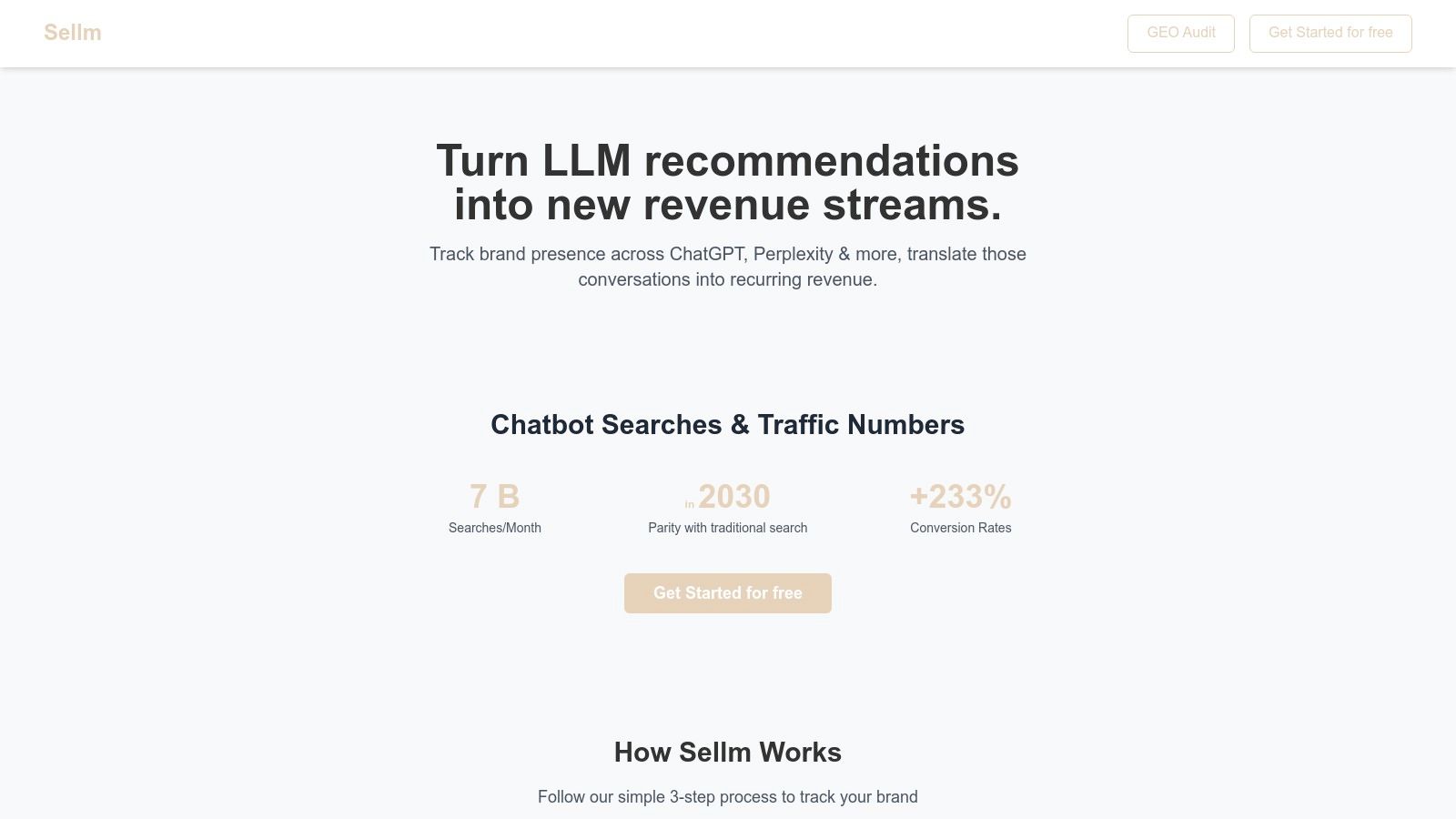
Sellm simplifies the complex world of GEO with a straightforward three-step process. Input your brand and industry, select relevant keywords, and receive actionable insights benchmarking your brand against competitors within the LLM ecosystem. This offers a distinct advantage over traditional brand monitoring tools that may not capture this rapidly expanding area of online interaction.
Pros and Cons of Sellm
Pros:
- Specialized GEO Monitoring: Optimize brand visibility specifically within AI and LLM outputs.
- Multi-Platform Tracking: Gain comprehensive insights across leading AI platforms.
- Actionable Insights: Leverage keyword and competitive ranking data to boost conversions.
- Flexible Pricing: Scalable plans from startups to enterprise-level needs.
Cons:
- Pricing for Small Businesses: Advanced features may be less accessible for very small businesses or freelancers.
- AI Focus: Primarily focused on AI-driven brand monitoring; less emphasis on traditional SEO or non-AI digital marketing channels.
Implementation and Use Cases
Setting up Sellm is designed to be user-friendly. The platform's intuitive interface allows you to quickly identify relevant keywords and track their performance across multiple LLMs. Practical use cases include:
- Monitoring Brand Mentions: Track how often and in what context your brand is mentioned by AI.
- Competitive Analysis: Understand how your brand visibility compares to competitors within the LLM landscape.
- Content Optimization: Refine content strategies based on AI-driven insights to improve brand recommendations and conversions.
Sellm's focus on GEO provides a valuable lens for understanding and optimizing brand presence in the rapidly evolving world of AI-driven search and recommendations (https://sellm.io). This positions it as a powerful brand monitoring tool for those seeking to capture future-proof digital exposure.
2. Brandwatch
Brandwatch is a leading consumer intelligence and social media management platform. It empowers businesses to monitor online conversations, analyze consumer sentiment, and manage their brand reputation. Its extensive archive pulls data from over 100 million online sources. This provides deep insights into market trends and consumer behavior, valuable for understanding brand perception within the broader digital landscape.
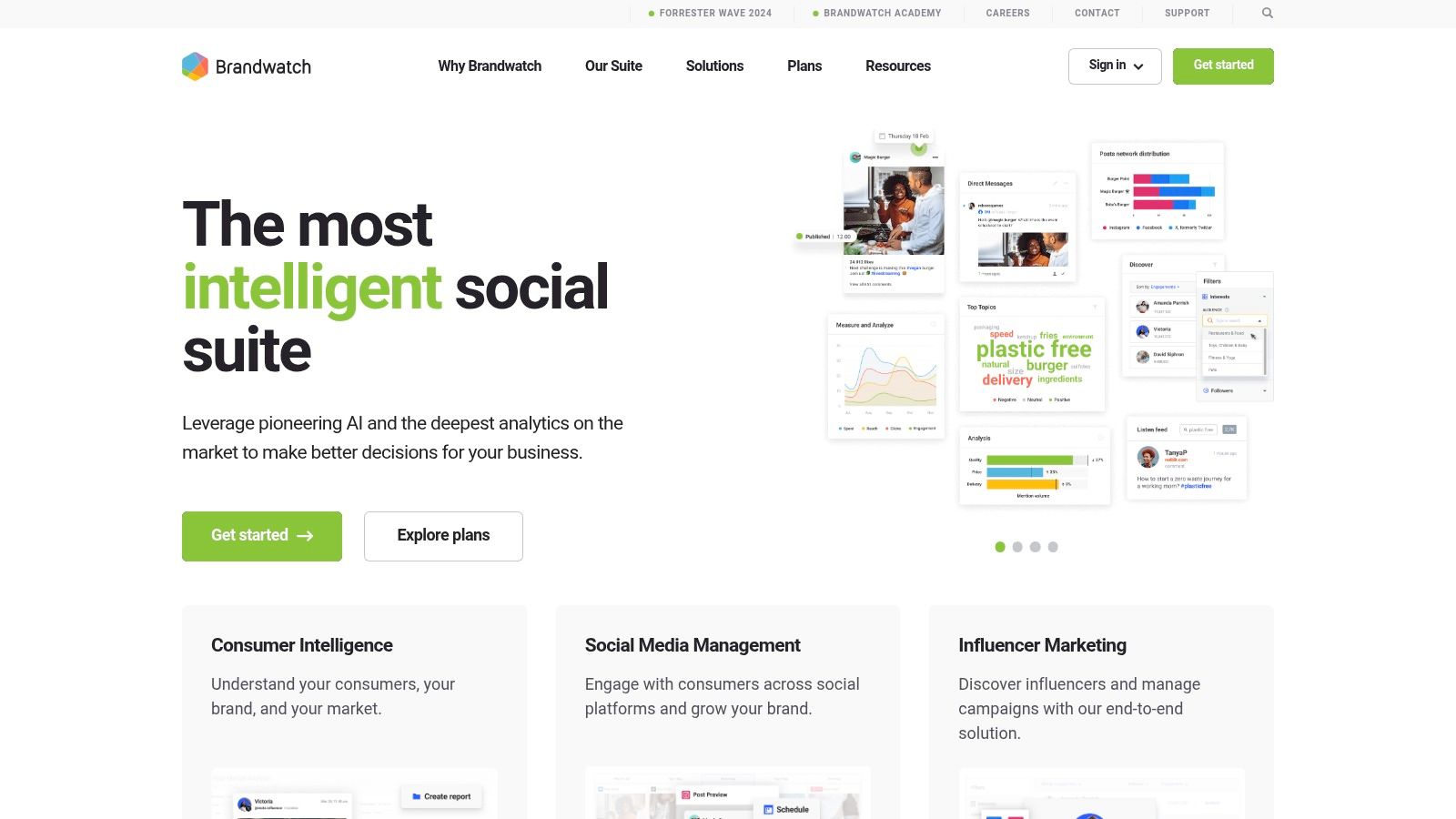
Brandwatch excels at providing historical data, going back as far as 2010. This allows for in-depth trend analysis and understanding long-term brand perception shifts. Its AI-powered sentiment analysis helps dissect nuanced online conversations. This allows users to go beyond simple mentions and understand the emotional context surrounding their brand. While not specifically focused on GEO/LLMs like Sellm, its comprehensive data coverage offers valuable insights for a holistic brand monitoring strategy.
Pros and Cons of Brandwatch
Pros:
- Extensive Data Coverage: Access a massive dataset for comprehensive brand monitoring.
- Historical Data Analysis: Uncover long-term trends and brand perception shifts.
- Robust Sentiment Analysis: Understand the emotional context of online conversations.
- Powerful Visualization Tools: Clearly present complex data insights.
Cons:
- Steeper Learning Curve: Requires time investment to master its features.
- Higher Pricing: May not be suitable for smaller businesses or tight budgets.
- Less GEO/LLM Focus: Primarily focuses on traditional social media and online channels.
Implementation and Use Cases
Brandwatch is a powerful tool, but requires a strategic approach to implementation. Defining clear objectives and KPIs is crucial. Practical use cases include tracking brand mentions across social media platforms, analyzing competitor strategies, and identifying emerging market trends. The platform's customizable dashboards and reporting features enable tailored insights.
Brandwatch's strength lies in its comprehensive data coverage and advanced analytics (https://www.brandwatch.com/). It provides a broad view of brand health across the digital ecosystem. This makes it a valuable tool for larger enterprises seeking in-depth consumer intelligence and brand reputation management.
3. Mention
Mention stands out as a real-time brand monitoring tool, ideal for tracking brand mentions across diverse online platforms. This includes social media, news sites, blogs, forums, and more. Its focus on real-time monitoring allows businesses to quickly identify and address online conversations, effectively managing brand reputation. Mention also offers valuable insights into competitor activities and emerging trends.

Mention simplifies the process of monitoring your brand's online presence. It provides a user-friendly interface for tracking mentions, analyzing sentiment, and identifying influencers. This allows businesses to understand public perception and tailor their strategies accordingly. While Mention excels in real-time monitoring, its historical data access is somewhat limited.
Pros and Cons of Mention
Pros:
- Real-Time Monitoring: Stay informed about brand mentions as they happen across various platforms.
- User-Friendly Interface: Easily set up and navigate the platform to track mentions and analyze data.
- Affordable Pricing: Accessible pricing plans suitable for businesses of all sizes.
- Comprehensive Coverage: Monitor mentions across a wide range of online sources.
Cons:
- Limited Historical Data: Access to historical data may be restricted, especially on lower-tier plans.
- Advanced Features: Some advanced features, such as in-depth competitor analysis, might require higher-tier subscriptions.
Implementation and Use Cases
Setting up Mention is straightforward, even for users with limited technical expertise. Its intuitive dashboard makes it easy to define keywords, select relevant platforms, and customize alerts. Practical use cases include:
- Real-Time Crisis Management: Quickly identify and address negative sentiment or misinformation.
- Competitor Benchmarking: Track competitor mentions to understand their strategies and market positioning.
- Influencer Identification: Discover relevant influencers mentioning your brand or industry.
Mention's real-time monitoring capabilities and user-friendly interface (https://mention.com/) make it a valuable tool for businesses looking to stay on top of their online presence and manage their brand reputation proactively. While less focused on the burgeoning field of GEO and LLMs, it offers essential brand monitoring across traditional digital channels.
4. Brand24
Brand24 excels as a social listening tool, monitoring your brand mentions across various online platforms. These include social media, news sites, blogs, forums, and more. It provides real-time insights and analytics to help manage brand reputation, making it a valuable asset for understanding public perception and identifying potential crises.
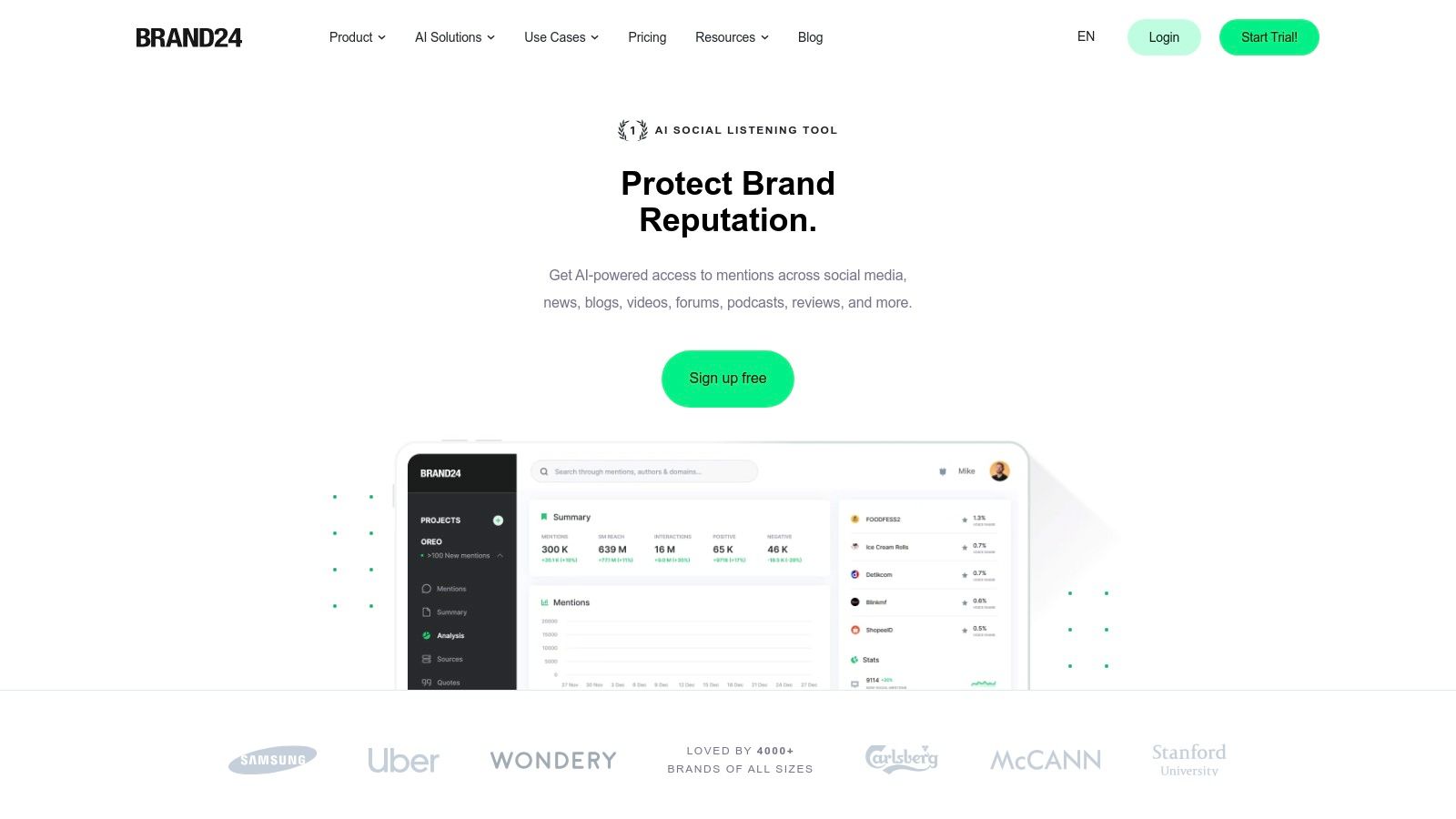
Brand24 simplifies social listening with an intuitive interface. It helps users quickly identify relevant conversations and analyze sentiment. Its hashtag tracking capabilities prove particularly useful for understanding how campaigns resonate with the target audience. This allows for data-driven adjustments to maximize impact and manage any negative feedback effectively.
Pros and Cons of Brand24
Pros:
- Intuitive Interface: Easy to navigate and use, even for beginners.
- Affordable Pricing: Offers plans accessible to various budgets.
- Comprehensive Coverage: Monitors a wide range of online sources.
- Real-Time Monitoring: Quickly identifies and addresses emerging issues.
Cons:
- Limited Integrations: Fewer integration options compared to some competitors.
- Advanced Features: Accessing advanced features often requires higher-tier plans.
Implementation and Use Cases
Setting up Brand24 is straightforward. Define your brand keywords and the platform automatically begins tracking mentions. Practical use cases include:
- Reputation Management: Address negative reviews and comments promptly.
- Campaign Tracking: Analyze hashtag performance and audience sentiment.
- Competitive Analysis: Monitor competitor mentions and identify industry trends.
- Influencer Marketing: Discover and connect with relevant influencers.
Brand24's focus on real-time monitoring and sentiment analysis makes it a valuable tool for managing brand reputation (https://brand24.com/). It allows businesses to stay informed about online conversations and proactively address any emerging issues, contributing to a stronger brand image.
5. Talkwalker
Talkwalker is a robust social listening and analytics platform ideal for brands needing comprehensive reputation management. It monitors online conversations across a wide spectrum of sources, from social media and news sites to blogs, forums, and even podcasts. This broad coverage makes it a valuable tool for understanding the nuances of brand perception and identifying potential PR crises before they escalate. Its advanced AI-powered sentiment analysis goes beyond simple keyword tracking, providing a deeper understanding of the emotional context surrounding brand mentions.
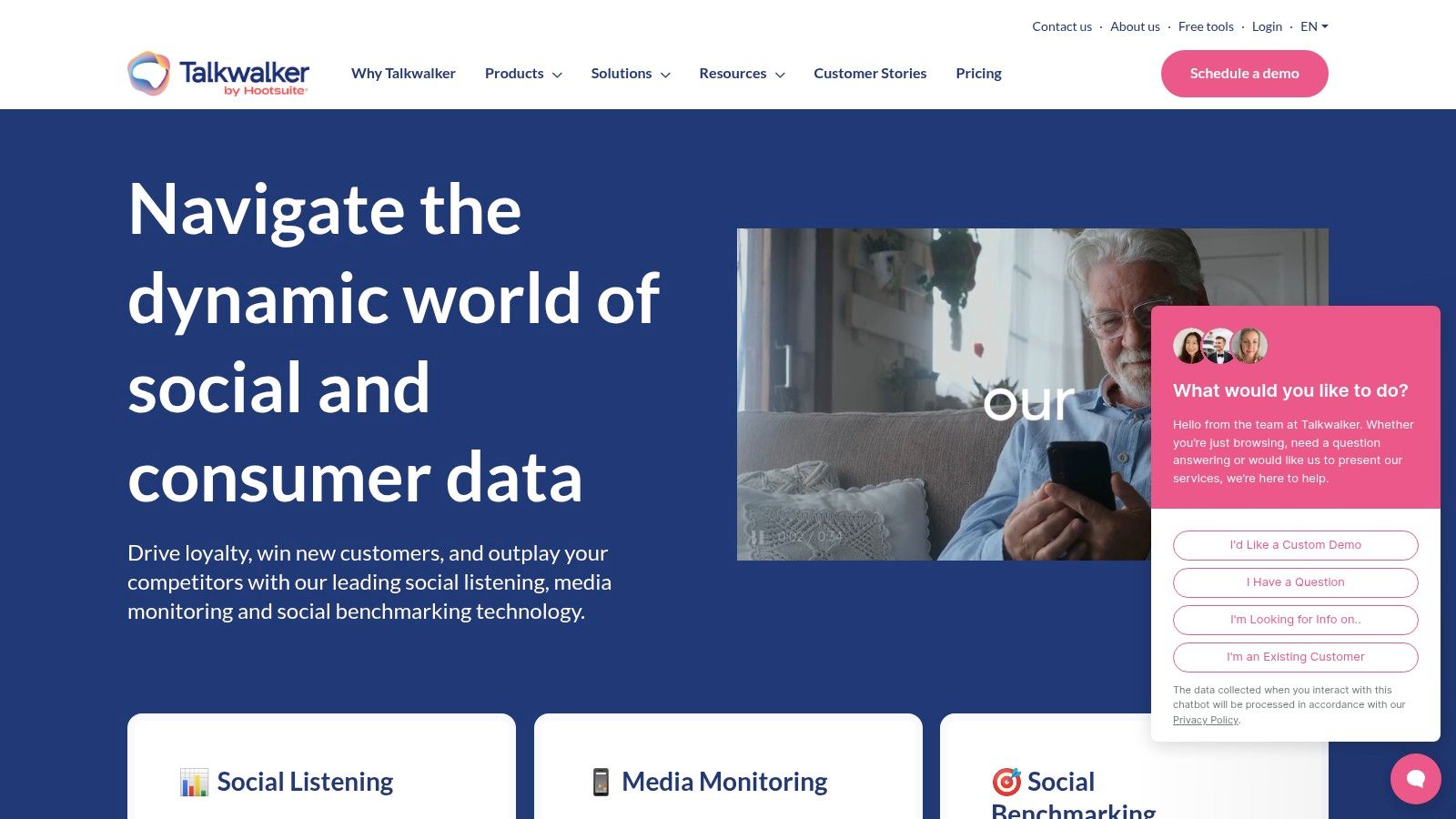
Talkwalker's image recognition capabilities add another layer of monitoring, detecting brand logos even without explicit text mentions. This is particularly useful for visually driven brands or those concerned about unauthorized logo usage. Its competitive benchmarking features allow you to compare your brand's performance against key competitors, providing valuable context for strategic decision-making. Customizable dashboards and reporting tools offer flexibility for tailoring data visualization to specific business needs.
Pros and Cons of Talkwalker
Pros:
- Comprehensive Coverage: Monitors a broad range of online platforms, including social media, news, blogs, forums, and podcasts.
- Advanced Analytics: Offers AI-powered sentiment analysis, trend detection, and image recognition.
- Multilingual Support: Facilitates global brand monitoring across different languages and regions.
Cons:
- Pricing: Can be expensive for small businesses or those with limited budgets.
- Learning Curve: The platform's advanced features may require a steeper learning curve for new users.
Implementation and Use Cases
Talkwalker is best suited for brands with established online presences and a dedicated social listening strategy. The platform's depth of features requires a commitment to data analysis and interpretation. Practical use cases include:
- Crisis Management: Quickly identify and address negative sentiment or emerging PR issues.
- Campaign Tracking: Measure the impact of marketing campaigns on brand perception and engagement.
- Competitive Intelligence: Gain insights into competitor strategies and brand positioning.
Talkwalker's comprehensive approach to social listening and analytics (https://www.talkwalker.com/) provides valuable insights for brands seeking to understand and manage their online reputation. It offers powerful tools for monitoring brand mentions, analyzing sentiment, and tracking the competitive landscape, though its advanced features and pricing may be more suitable for larger organizations.
6. Meltwater
Meltwater is a media intelligence platform that gives you a comprehensive view of your brand's online presence. It monitors online news, social media, blogs, forums, and other digital channels to provide insights into brand perception, industry trends, and competitor activity. This makes it a valuable tool for understanding how your brand is perceived and identifying potential risks and opportunities. For those exploring the evolving landscape of AI-driven analytics, you might find this article on AI-driven analytics SaaS insightful: Learn more about....

Meltwater's real-time monitoring capabilities allow you to stay on top of brand mentions and emerging conversations. Its advanced analytics tools help you understand the sentiment around your brand, track key industry trends, and benchmark your performance against competitors. This breadth of features positions Meltwater as a robust solution for brands seeking in-depth media intelligence.
Pros and Cons of Meltwater
Pros:
- Extensive Media Coverage: Accesses a vast network of online news, social media, and other digital platforms.
- Advanced Analytics: Offers sentiment analysis, trend detection, and competitive benchmarking.
- User-Friendly Interface: Features customizable dashboards and reporting tools.
Cons:
- Pricing: Can be expensive, particularly for smaller businesses with limited budgets.
- Training: Some advanced features may require additional training to utilize effectively.
Implementation and Use Cases
Meltwater is designed for various use cases, from daily brand monitoring to in-depth market research. Setting up custom alerts allows you to be notified of critical brand mentions or emerging crises. The platform's reporting tools facilitate data-driven decision-making. Some practical applications include:
- Crisis Management: Quickly identify and respond to negative press or social media mentions.
- Competitive Analysis: Track competitor activity and identify opportunities to gain market share.
- Market Research: Understand industry trends and consumer sentiment to inform product development and marketing strategies.
7. Hootsuite Insights
Hootsuite Insights, powered by Brandwatch, offers robust social listening capabilities, making it a valuable brand monitoring tool. Its strength lies in tracking brand mentions and analyzing conversations across various social media platforms. This enables businesses to understand public perception and react to trending topics in real-time. For brands heavily invested in social media, Hootsuite Insights provides crucial data for managing online reputation and informing social media strategies. For those exploring AI-driven content strategies, check out this insightful article on AI SEO: Learn more about how AI is changing SEO.
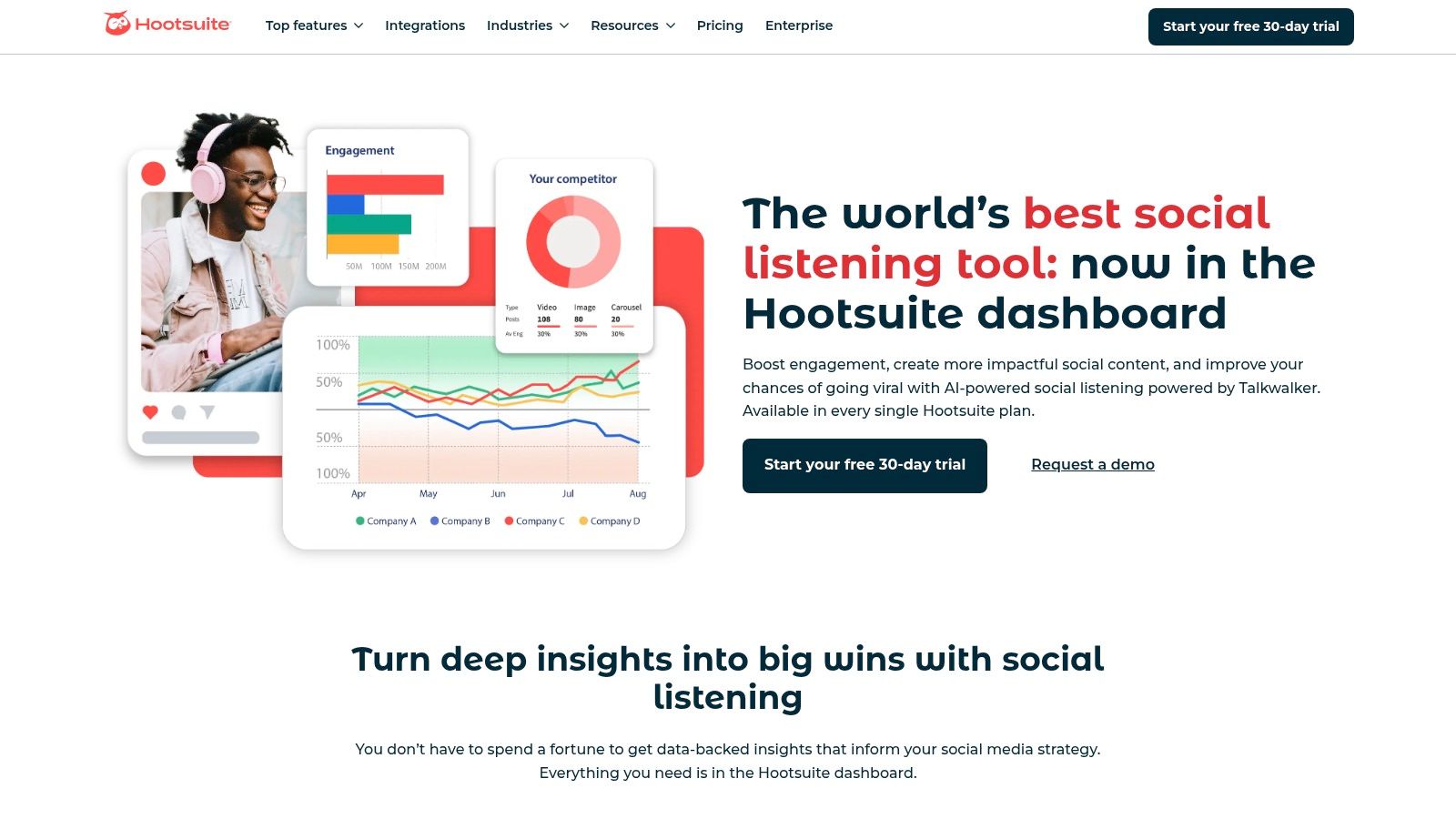
Hootsuite Insights simplifies social listening with a user-friendly interface and customizable dashboards. Its features include real-time monitoring, sentiment analysis, and competitive benchmarking. The seamless integration with Hootsuite's social media management platform streamlines workflows for social media teams. This integration allows users to quickly move from insight gathering to action.
Pros and Cons of Hootsuite Insights
Pros:
- Seamless Hootsuite Integration: Efficiently manage social media activities within a unified platform.
- User-Friendly Interface: Customizable dashboards provide clear visualizations of key metrics.
- Comprehensive Social Media Coverage: Monitor conversations and mentions across major social networks.
Cons:
- Limited Non-Social Coverage: Primarily focuses on social media; less effective for monitoring brand mentions on other digital channels.
- Advanced Features and Pricing: Accessing advanced analytics often requires higher-tier subscription plans.
Implementation and Use Cases
Implementing Hootsuite Insights is straightforward, particularly for existing Hootsuite users. The platform's intuitive design makes setting up monitoring streams and configuring dashboards relatively simple. Practical use cases include:
- Real-Time Crisis Management: Quickly identify and respond to negative sentiment or emerging brand crises on social media.
- Campaign Tracking: Analyze social media conversations surrounding specific campaigns to measure their impact and audience engagement.
- Competitive Benchmarking: Understand how your brand's social media performance compares to competitors.
8. Sprinklr
Sprinklr is a unified customer experience management (CXM) platform offering robust brand monitoring, social listening, and analytics. It spans a wide range of digital channels, making it suitable for enterprises seeking a holistic view of their brand presence. This includes emerging channels relevant to Generative Engine Optimization (GEO), allowing businesses to track brand mentions within the evolving landscape of AI-driven platforms.

Sprinklr's comprehensive coverage and AI-powered insights help brands understand customer sentiment, track competitors, and identify emerging trends. Its customizable dashboards and reporting features allow for tailored insights, valuable for large enterprises needing to monitor complex brand ecosystems. Sprinklr's integration with customer service and marketing platforms streamlines workflows and enhances data-driven decision making.
Pros and Cons of Sprinklr
Pros:
- Comprehensive Channel Coverage: Monitors 30+ digital channels, including those relevant to GEO/LLMs.
- AI-Powered Analytics: Provides sentiment analysis, trend detection, and competitive benchmarking.
- Scalable Solution: Suited for large enterprises with complex brand monitoring needs.
Cons:
- Higher Pricing: May be less accessible for smaller businesses or those with limited budgets.
- Steeper Learning Curve: Advanced features may require more time for users to master.
Implementation and Use Cases
Implementing Sprinklr requires careful planning and configuration to leverage its full potential. Large enterprises will benefit most from its extensive features and integrations. Practical use cases include:
- Crisis Management: Real-time monitoring allows quick responses to negative brand mentions or emerging crises.
- Campaign Tracking: Measure the effectiveness of marketing campaigns across various digital channels.
- Competitive Analysis: Benchmark brand performance against competitors and identify opportunities.
Sprinklr's robust capabilities and broad channel coverage make it a powerful brand monitoring tool (https://www.sprinklr.com/). This is especially true for enterprises seeking a comprehensive and integrated platform to manage their brand presence across the digital landscape, including the evolving field of GEO.
9. Awario
Awario is a social media and web monitoring tool that tracks brand mentions, keywords, and competitors across various online platforms. It's particularly useful for understanding the public's sentiment towards your brand and identifying potential crises before they escalate. This makes Awario a valuable tool for businesses looking to stay ahead of online conversations and protect their brand reputation.
Awario offers real-time monitoring, allowing you to react quickly to both positive and negative mentions. Its Boolean search functionality helps refine monitoring to specific keywords and phrases, minimizing irrelevant results. While Awario traditionally focuses on established social media and web platforms, its flexible keyword tracking can be extended to monitor mentions within emerging AI-driven content. Learn more about Awario and AI integration in blog automation: Learn more about....
Pros and Cons of Awario
Pros:
- Affordable Pricing: Suitable for small to medium-sized businesses.
- User-Friendly Interface: Easy setup and intuitive navigation.
- Comprehensive Coverage: Monitors a wide range of online sources.
- Real-time Alerts: Stay informed of important mentions as they happen.
Cons:
- Limited Integrations: May require manual data transfer to other platforms.
- Advanced Features: More sophisticated features like sentiment analysis and competitive benchmarking may require higher-tier plans.
Implementation and Use Cases
Setting up Awario is straightforward. Simply define the keywords and brand names you want to monitor, set up alerts, and begin tracking. Practical use cases include:
- Crisis Management: Identify and address negative sentiment before it impacts your brand.
- Market Research: Understand customer conversations and identify emerging trends.
- Competitive Analysis: Track competitor mentions and strategies.
- Lead Generation: Discover potential customers talking about your industry or products.
Awario provides a comprehensive suite of brand monitoring tools suitable for businesses of all sizes seeking to actively manage their online presence.
10. YouScan
YouScan is a social media listening platform providing businesses with insights into brand perception and consumer behavior. Its strength lies in analyzing both text and images, making it particularly useful for brand monitoring in visually-rich social media environments. This is crucial for understanding how your brand is presented, not just in text mentions, but also in user-generated photos and videos. This offers a more comprehensive view than text-based brand monitoring tools.
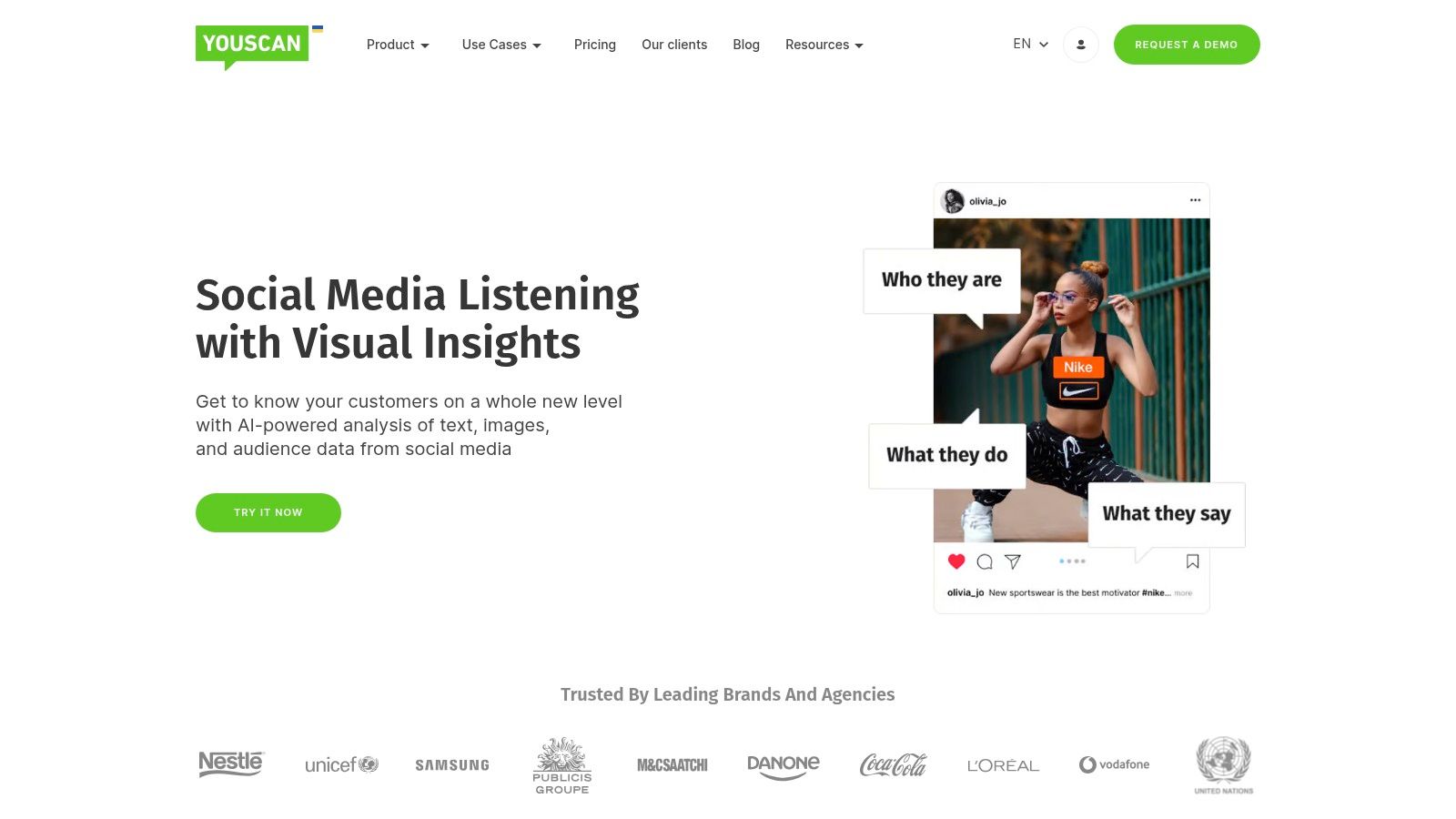
YouScan simplifies social listening with a user-friendly interface and customizable dashboards. Its AI-powered image recognition accurately detects brand logos and products, even in complex visual contexts. This feature proves especially valuable for tracking brand presence in user-generated content and understanding how customers visually interact with your products.
Pros and Cons of YouScan
Pros:
- Advanced Image Recognition: Identify your brand's visual presence across social media.
- Comprehensive Social Media Coverage: Monitor various platforms for a holistic view.
- User-Friendly Interface: Easy setup and customizable dashboards for efficient data analysis.
Cons:
- Pricing: Potentially expensive for small businesses with limited budgets.
- Limited Integrations: May lack seamless integration with certain marketing automation or CRM platforms.
Implementation and Use Cases
YouScan is relatively straightforward to implement, with a user-friendly interface that facilitates quick setup and data analysis. Practical use cases for brand monitoring include:
- Visual Brand Tracking: Monitor brand logo appearances in user-generated content.
- Sentiment Analysis: Gauge public opinion towards your brand based on image and text analysis.
- Competitive Analysis: Benchmark your brand against competitors' visual presence and sentiment.
YouScan's focus on visual brand monitoring offers a distinct advantage in today's image-centric social media landscape (https://youscan.io/). This makes it a powerful brand monitoring tool for businesses seeking a comprehensive understanding of their online presence.
11. Keyhole
Keyhole is a social media analytics and brand monitoring tool specializing in tracking brand mentions, hashtags, and keywords across various platforms. This makes it valuable for understanding public perception and the overall impact of social media campaigns. While not specifically designed for Generative Engine Optimization (GEO) like Sellm, Keyhole provides crucial insights into traditional social media brand presence, complementing a broader brand monitoring strategy.
Keyhole simplifies social listening with real-time monitoring and sentiment analysis. This allows you to quickly assess public opinion surrounding your brand and campaigns. It also offers influencer identification and competitive analysis, giving you a comprehensive view of your brand's social landscape. This data can inform adjustments to social media strategies and enhance campaign effectiveness.
Pros and Cons of Keyhole
Pros:
- User-Friendly Interface: Easy setup and navigation simplifies social media monitoring.
- Affordable Pricing: Suitable for small to medium-sized businesses seeking cost-effective social listening.
- Comprehensive Social Coverage: Tracks data across major social media platforms.
- Real-Time Monitoring: Immediate insights into brand mentions and trending topics.
Cons:
- Limited Non-Social Coverage: Primarily focused on social media; less emphasis on other digital channels, including LLMs and AI platforms.
- Advanced Features & Costs: Some advanced features may require higher-tier subscription plans.
Implementation and Use Cases
Keyhole's intuitive interface allows for quick setup and campaign tracking. Define relevant keywords and hashtags to monitor brand mentions and sentiment. Practical use cases include:
- Campaign Tracking: Analyze hashtag performance and overall social media engagement during campaigns.
- Crisis Management: Identify and respond to negative sentiment or emerging crises in real time.
- Competitive Benchmarking: Track competitor activity and identify opportunities to improve social media strategies.
Keyhole's strength lies in its user-friendly approach to social listening (https://keyhole.co/). While not a dedicated GEO tool, its focus on social media brand monitoring provides valuable data to complement AI-driven insights and create a comprehensive brand monitoring strategy.
12. BrandMentions
BrandMentions is a web and social media monitoring tool that efficiently tracks brand mentions, keywords, and competitors across diverse online platforms. Its strength lies in providing a comprehensive overview of your brand's online presence, allowing you to quickly identify and address both positive and negative sentiment. This makes it a valuable tool for managing online reputation and understanding public perception.

BrandMentions simplifies brand monitoring with real-time alerts and a user-friendly dashboard. You can easily track mentions across news sites, blogs, forums, and social media platforms, gaining valuable insights into where and how your brand is being discussed. This broad coverage is particularly useful for brands seeking to understand their overall online footprint.
Pros and Cons of BrandMentions
Pros:
- Comprehensive Coverage: Monitors brand mentions across a wide range of online sources.
- Real-time Alerts: Provides instant notifications of new brand mentions.
- Sentiment Analysis: Assesses the overall tone of brand mentions (positive, negative, neutral).
- Affordable Pricing: Suitable for businesses of all sizes.
Cons:
- Limited Integrations: Fewer integrations compared to some other brand monitoring tools.
- Advanced Features: Some advanced features, like influencer identification, may require higher-tier plans.
Implementation and Use Cases
Setting up BrandMentions is straightforward, with a user-friendly interface that requires minimal technical expertise. The platform allows you to quickly define keywords and competitors to track. Practical use cases include:
- Reputation Management: Identifying and addressing negative reviews or mentions.
- Competitive Analysis: Tracking competitor activity and brand mentions.
- Market Research: Understanding public perception of your brand and industry trends.
BrandMentions offers a robust solution for tracking brand visibility across traditional online channels (https://brandmentions.com/). This comprehensive approach makes it a valuable brand monitoring tool, particularly for those focused on managing online reputation and understanding customer sentiment.
Brand Monitoring Tools Feature Comparison
| Platform | Core Features | User Experience & Quality | Value Proposition | Target Audience | Price Point |
|---|---|---|---|---|---|
| Sellm | GEO monitoring in AI & LLMs, keyword tracking | Simple 3-step process, monthly reports | Boosts AI brand visibility, up to 233% conv. | SEO experts, marketing teams | Flexible, entry-level to enterprise |
| Brandwatch | Social listening, sentiment analysis, dashboards | Robust analytics, steep learning curve | Extensive historic data & deep consumer insights | Enterprises | Higher, enterprise-focused |
| Mention | Real-time brand mentions, sentiment, alerts | User-friendly, easy setup | Affordable, good platform coverage | SMBs | Affordable |
| Brand24 | Real-time monitoring, sentiment, influencer | Intuitive interface | Affordable with broad online source coverage | SMBs | Affordable |
| Talkwalker | Monitoring, sentiment, image recognition | Advanced analytics, multilingual support | Strong analytics, global coverage | Medium to large businesses | Higher |
| Meltwater | Media monitoring, sentiment, influencer tracking | User-friendly, customizable dashboards | Extensive media coverage | Medium to large businesses | Higher |
| Hootsuite Insights | Social monitoring, sentiment, integrated with Hootsuite | User-friendly, platform integration | Seamless for Hootsuite users | Social media managers | Mid to high |
| Sprinklr | Multi-channel monitoring, AI analytics | Scalable, complex features | Enterprise-grade CX and monitoring | Large enterprises | High |
| Awario | Real-time mentions, sentiment, Boolean search | Easy setup, user-friendly | Affordable, broad source coverage | SMBs | Affordable |
| YouScan | Monitoring, AI image recognition, sentiment | Customizable dashboards | Advanced image recognition | Medium to large businesses | Higher |
| Keyhole | Mentions, hashtags, influencer tracking | Easy setup, friendly interface | Affordable social media analytics | SMBs | Affordable |
| BrandMentions | Mentions, sentiment, influencer tracking | User-friendly, alerts | Affordable monitoring | SMBs | Affordable |
Choosing the Right Brand Monitoring Tool for GEO and LLM Success
Navigating the crowded landscape of brand monitoring tools can be daunting. This in-depth review has explored twelve leading platforms, examining their strengths and weaknesses in the context of GEO and Large Language Model (LLM) applications. From established players like Brandwatch and Meltwater to emerging solutions such as Awario and YouScan, each tool offers a unique approach to tracking brand mentions and analyzing online conversations. This section distills the key takeaways to help you choose the right solution for your specific needs.
Key Considerations for GEO and LLM Integration
When integrating brand monitoring with GEO and LLM technologies, certain factors become paramount. Accurate location data is crucial for understanding regional brand sentiment and identifying emerging trends. LLM integration, on the other hand, unlocks advanced sentiment analysis, automated reporting, and even predictive capabilities. Consider these factors when evaluating tools:
- GEO precision: How accurately does the tool identify the location of mentions? Does it offer granular data for hyperlocal campaigns?
- LLM compatibility: Does the tool integrate with popular LLM platforms? Can it leverage LLMs for sentiment analysis and content generation?
- Data visualization: How effectively does the tool visualize GEO and LLM-derived insights? Are the dashboards customizable and easy to understand?
Matching Tools to Your Needs
Choosing the right tool hinges on your specific requirements and resources. For comprehensive enterprise-level monitoring with advanced LLM integration, platforms like Brandwatch and Sprinklr may be suitable. If your focus is primarily on social listening and real-time alerts, tools like Mention and Brand24 might be a better fit. For image and video analysis powered by AI, consider YouScan. And for those seeking a balance of powerful features and affordability, platforms like Awario and Keyhole offer compelling options.
Remember to evaluate the practical implementation considerations. Onboarding time, team training requirements, and ongoing support can significantly impact the tool's effectiveness. Factor these aspects into your decision-making process.
The Importance of Scalability and Integration
As your business grows and your brand monitoring needs evolve, scalability becomes critical. Choose a tool that can adapt to increasing data volumes and integrate seamlessly with your existing marketing technology stack. This ensures a smooth transition and maximizes the value of your investment.
Taking the Next Step in Brand Monitoring
Effective brand monitoring is no longer a luxury; it's a necessity in today's digital landscape. By leveraging the insights gleaned from this review, you can confidently choose a brand monitoring tool that empowers you to track your brand reputation, understand customer sentiment, and make data-driven decisions. Harness the power of these tools to stay ahead of the curve and drive meaningful business outcomes.
Choosing the right brand monitoring tool requires careful consideration of your unique needs, from GEO targeting and LLM integration to scalability and pricing. To streamline your brand monitoring and leverage the power of GEO and LLM insights, explore Sellm (Sellm). Sellm provides a comprehensive suite of tools designed to enhance your brand presence and empower data-driven decision-making.